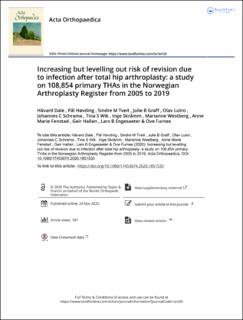| dc.description.abstract | Background and purpose — Focus on prevention, surveillance, and treatment of infection after total hip arthroplasty (THA) in the last decade has resulted in new knowledge and guidelines. Previous publications have suggested an increased incidence of surgical revisions due to infection after THA. We assessed whether there have been changes in the risk of revision due to deep infection after primary THAs reported to the Norwegian Arthroplasty Register (NAR) over the period 2005–2019.
Patients and methods — Primary THAs reported to the NAR from January 1, 2005 to December 31, 2019 were included. Adjusted Cox regression analyses with the first revision due to deep infection after primary THA were performed. We investigated changes in the risk of revision as a function of time of primary THA. Time was stratified into 5-year periods. We studied the whole population of THAs, and the subgroups: all-cemented, all-uncemented, reverse hybrid (cemented cup), and hybrid THAs (cemented stem). In addition, we investigated factors that were associated with the risk of revision, and changes in the time span from primary THA to revision.
Results — Of the 108,854 primary THAs that met the inclusion criteria, 1,365 (1.3%) were revised due to deep infection. The risk of revision due to infection, at any time after primary surgery, increased through the period studied. Compared with THAs implanted in 2005–2009, the relative risk of revision due to infection was 1.4 (95% CI 1.2–1.7) for 2010–2014, and 1.6 (1.1–1.9) for 2015–2019. We found an increased risk for all types of implant fixation. Compared to 2005–2009, for all THAs, the risk of revision due to infection 0–30 days postoperatively was 2.2 (1.8–2.8) for 2010– 2014 and 2.3 (1.8–2.9) for 2015–2019, 31–90 days postoperatively 1.0 (0.7–1.6) for 2010–2014 and 1.6 (1.0–2.5) for 2015–2019, and finally 91 days–1 year postoperatively 1.1 (0.7–1.8) for 2010–2014 and 1.6 (1.0–2.6) for 2015–2019. From 1 to 5 years postoperatively, the risk of revision due to infection was similar to 2005–2009 for both the subsequent time periods
Interpretation — The risk of revision due to deep infection after THA increased throughout the period 2005–2019, but appears to have levelled out after 2010. The increase was mainly due to an increased risk of early revisions, and may partly have been caused by a change of practice rather than a change in the incidence of infection. | en_US |

